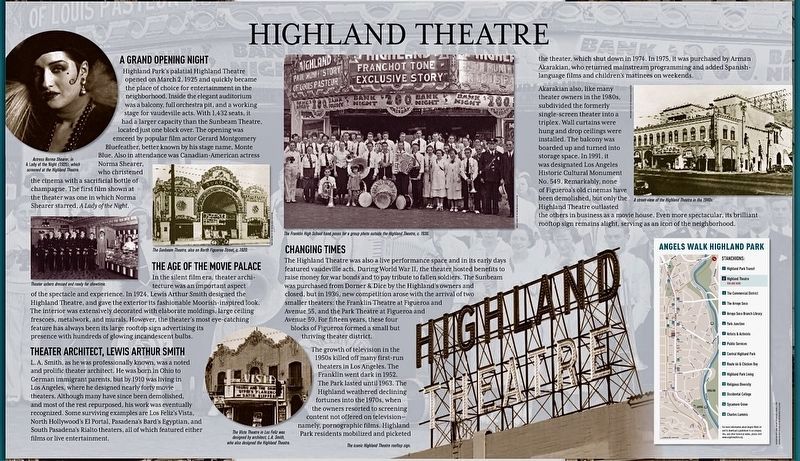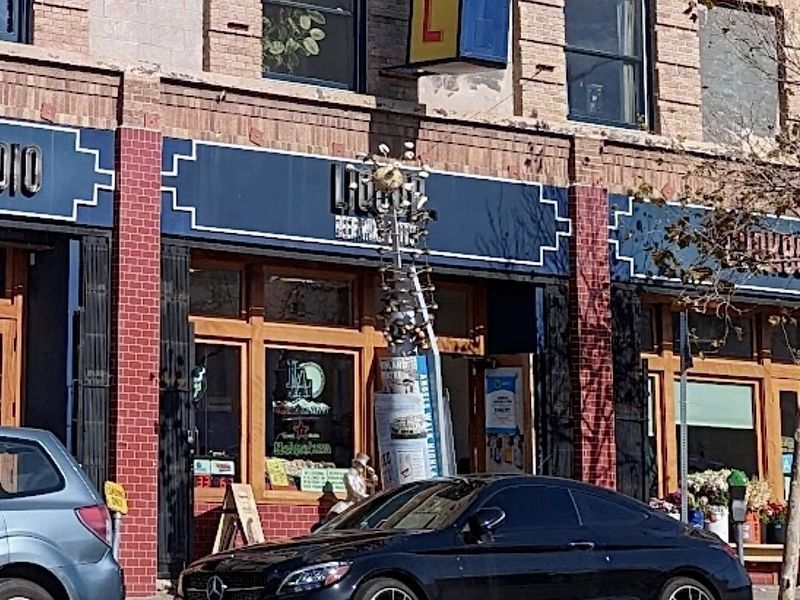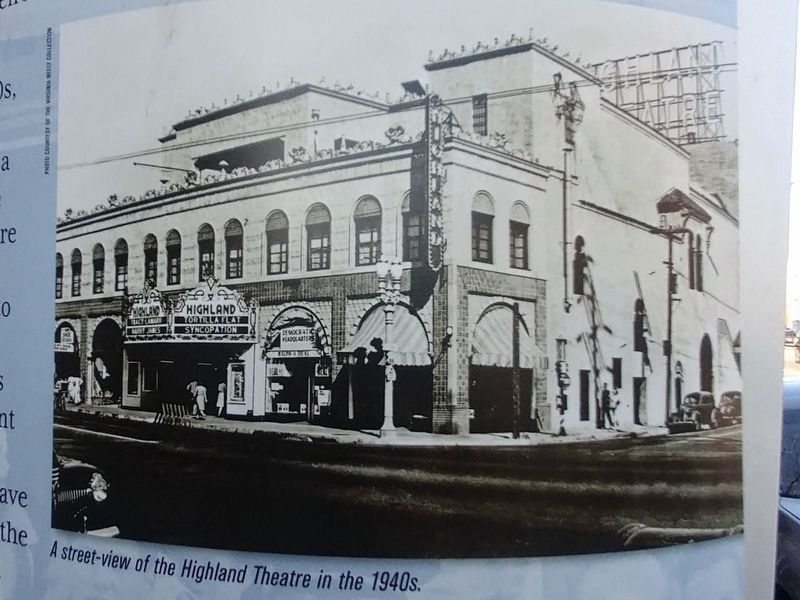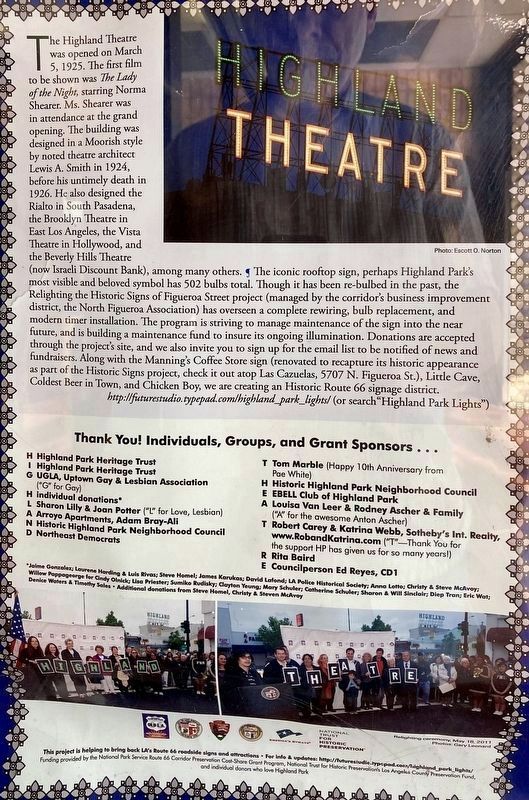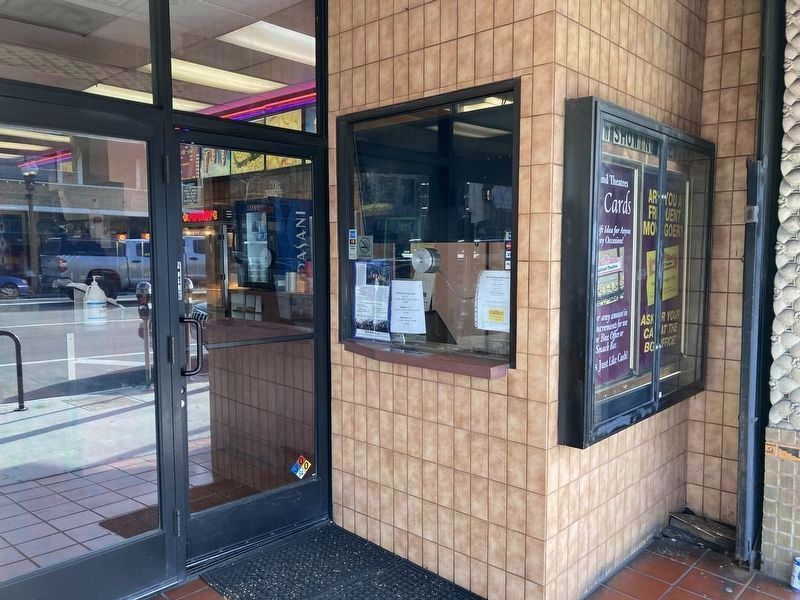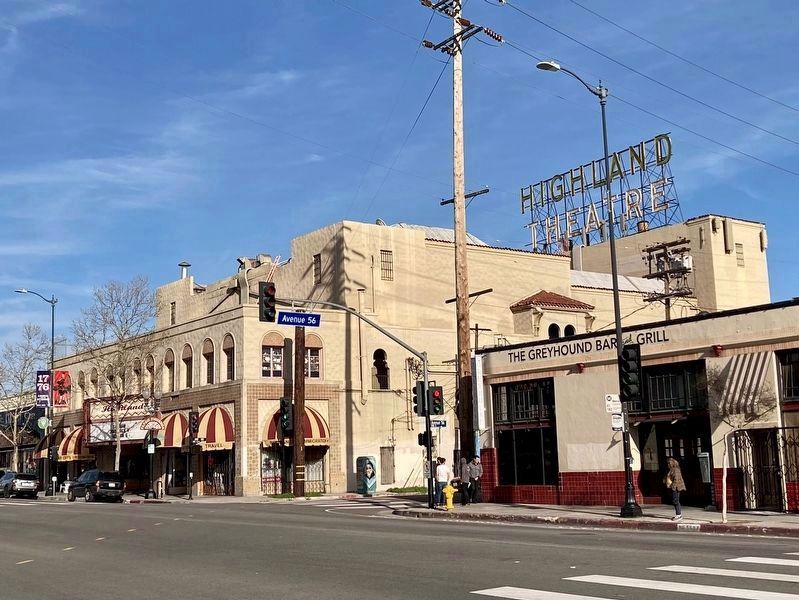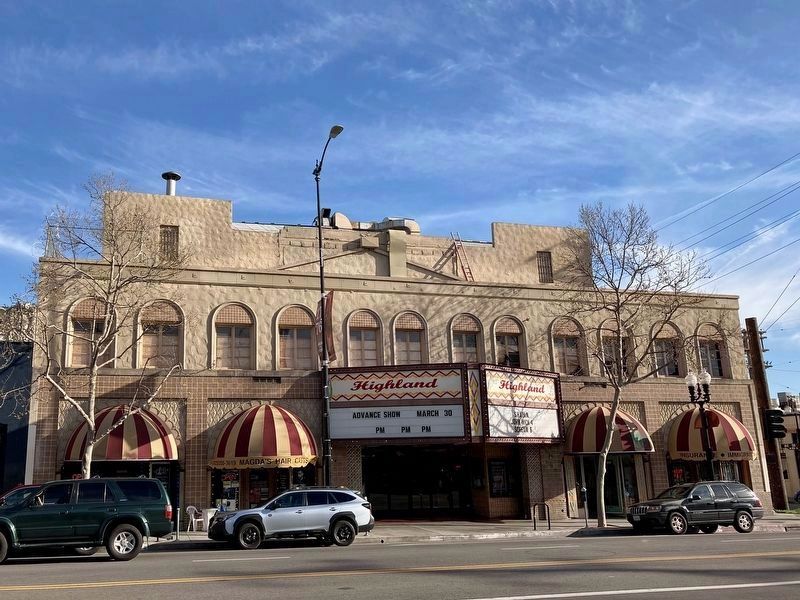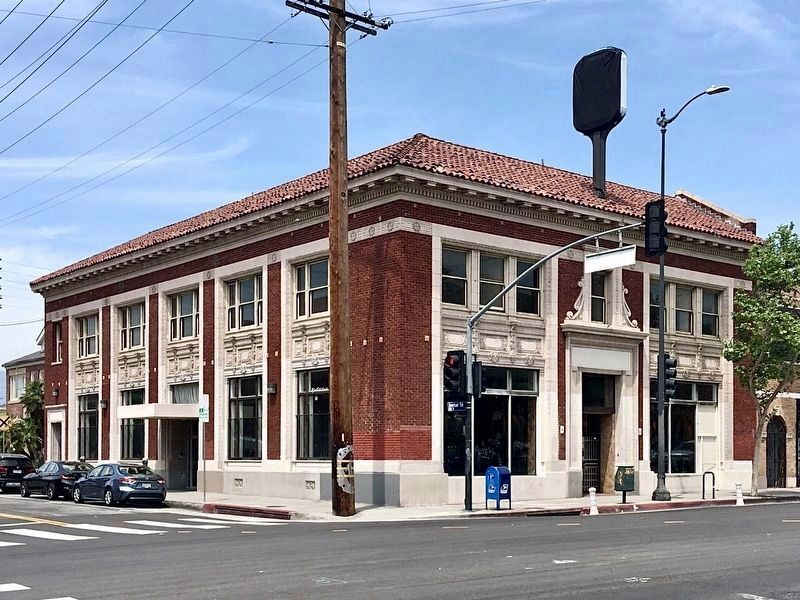Highland Park in Los Angeles in Los Angeles County, California — The American West (Pacific Coastal)
Highland Theatre
A Grand Opening Night
Highland Park's palatial Highland Theatre opened on March 2, 1925 and quickly became the place of choice for entertainment in the neighborhood. Inside the elegant auditorium was a balcony, full orchestra pit, and a working stage for vaudeville acts. With 1,432 seats, it had a larger capacity than the Sunbeam Theatre, located just one block over. The opening was emceed by popular film actor Gerard Montgomery Bluefeather, better known by his stage name, Monte Blue. Also in attendance was Canadian-American actress Norma Shearer, who christened the cinema with a sacrificial bottle of champagne. The first film shown at the theater was one in which Norma Shearer starred, A Lady of the Night.
The Age of the Movie Palace
In the silent film era, theater archi-tecture was an important aspect of the spectacle and experience. In 1924, Lewis Arthur Smith designed the Highland Theatre, and gave the exterior its fashionable Moorish-inspired look. The interior was extensively decorated with elaborate moldings, large ceiling frescoes, metalwork, and murals. However, the theater's most eye-catching feature has always been its large rooftop sign advertising its presence with hundreds of glowing incandescent bulbs.
Theater Architect, Lewis Arthur Smith
L.A. Smith, as he was professionally known, was a noted and prolific theater architect. He was born in Ohio to German immigrant parents, but by 1910 was living in Los Angeles, where he designed nearly forty movie theaters. Although many have since been demolished, and most of the rest repurposed, his work was eventually recognized. Some surviving examples are Los Feliz's Vista, North Hollywood's El Portal, Pasadena's Bard's Egyptian, and South Pasadena's Rialto theaters, all of which featured either films or live entertainment.
Changing Times
The Highland Theatre was also a live performance space and in its early days featured vaudeville acts. During World War II, the theater hosted benefits to raise money for war bonds and to pay tribute to fallen soldiers. The Sunbeam was purchased from Dorner & Dice by the Highland's owners and closed, but in 1936, new competition arose with the arrival of two smaller theaters: the Franklin Theatre at Figueroa and Avenue 55, and the Park Theatre at Figueroa and Avenue 59. For fifteen years, these four blocks of Figueroa formed a small but thriving theater district.
The growth of television in the 1950s killed off many first-run theaters in Los Angeles. The Franklin went dark in 1952. The Park lasted until 1963. The Highland weathered declining fortunes into the 1970s, when the owners resorted to screening content not offered on television — namely, pornographic films. Highland Park residents mobilized and picketed the theater, which shut down in 1974. In 1975, it was purchased by Arman Akarakian, who returned mainstream programming and added Spanish-language films and children's matinees on weekends.
Akarakian also, like many theater owners in the 1980s, subdivided the formerly single-screen theater into a triplex. Wall curtains were hung and drop ceilings were installed. The balcony was boarded up and turned into storage space. In 1991, it was designated Los Angeles Historic Cultural Monument No. 549. Remarkably, none of Figueroa's old cinemas have been demolished, but only the Highland Theatre outlasted the others in business as a movie house. Even more spectacular, its brilliant rooftop sign remains alight, serving as an icon of the neighborhood.
sign in theatre window:
The Highland Theatre was opened on March 5, 1925. The first film to be shown was The Lady of the Night, starring Norma Shearer. Ms. Shearer was in attendance at the grand opening. The building was designed in a Moorish style by noted theatre architect Lewis A. Smith in 1924, before his untimely death in 1926. He also designed the Rialto in South Pasadena, the Brooklyn Theatre in East Los Angeles, the Vista Theatre in Hollywood, and the Beverly Hills Theatre
(now Israeli Discount Bank), among many others.
The iconic rooftop sign, perhaps Highland Park's most visible and beloved symbol, has 502 bulbs total. Though it has been re-bulbed in the past, the Relighting the Historic Signs of Figueroa Street project (managcd by the corridor's business improvement district, the North Figueroa Association) has overseen a complete rewiring, bulb replacement, and modern timer installation. The program is striving to manage maintenance of the sign into the near future, and is building a maintenance fund to insure its ongoing illumination. Donations are accepted through the project's site, and we also invite you to sign up for the email list to be notified of news and fundraisers. Along with the Manning's Coffee Store sign (renovated to recapture its historic appearance as part of the Historic Signs project, check it out atop Las Cazuelas, 5707 N. Figueroa St.), Little Cave, Coldest Beer in Town, and Chicken Boy, we are creating an Historic Route 66 signage district.
Erected by City of Los Angeles. (Marker Number 549.)
Topics and series. This historical marker is listed in these topic lists: Architecture • Entertainment. In addition, it is included in the Los Angeles Historic-Cultural Monument series list. A significant historical date for this entry is March 2, 1925.
Location. 34° 6.542′ N, 118° 11.623′ W. Marker is in Los Angeles, California, in Los Angeles County. It is in Highland Park. Marker is at the intersection of Figueroa Street and Avenue 56, on the right when traveling north on Figueroa Street. Touch for map. Marker is at or near this postal address: 5604 N Figueroa St, Los Angeles CA 90042, United States of America. Touch for directions.
Other nearby markers. At least 8 other markers are within walking distance of this marker. Route 66 & Chicken Boy (within shouting distance of this marker); Smith House (about 400 feet away, measured in a direct line); Central Highland Park (about 400 feet away); Highland Park Ebell Club (about 400 feet away); The Commercial District (about 600 feet away); Highland Park Transit (about 600 feet away); G.W.E. Griffith House (approx. ¼ mile away); Public Services (approx. ¼ mile away). Touch for a list and map of all markers in Los Angeles.
More about this marker. The Angels Walk L.A. interpretive sign/stanchion was removed by the City of Los Angeles after it was damaged, and it has not been replaced (as of March 2023).
Regarding Highland Theatre. The building sold in 2023 to a developer who plans to restore the theatre.
Also see . . .
1. Angels Walk L.A. Self-guided walking tours of historic neighborhoods in Los Angeles. The Highland Theatre marker is part of the Highland Park walk. (Submitted on March 28, 2023.)
2. Highland Park Lights. Historic rooftop sign restoration. (Submitted on March 28, 2023.)
Credits. This page was last revised on April 4, 2023. It was originally submitted on March 28, 2023, by Craig Baker of Sylmar, California. This page has been viewed 266 times since then and 126 times this year. Photos: 1, 2, 3, 4, 5, 6, 7, 8. submitted on March 28, 2023, by Craig Baker of Sylmar, California.
